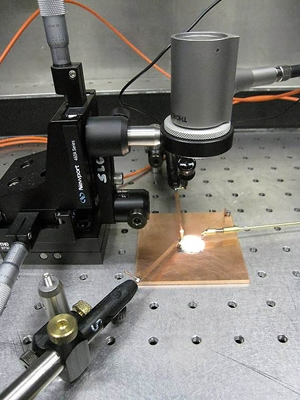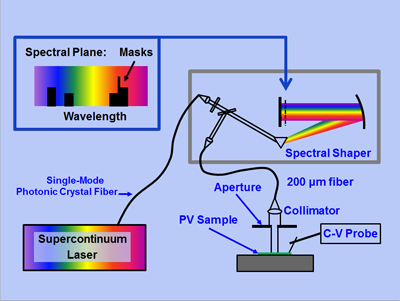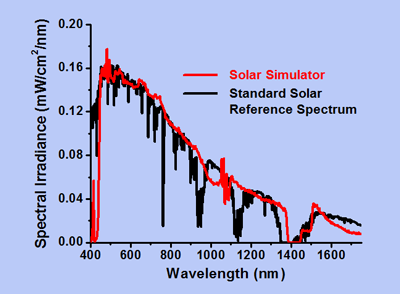Simulating the sun for photovoltaic research

PML researchers have devised a novel source of portable sunlight that may fill an urgent need in renewable energy research – namely, light sources that generate a near-perfect solar spectrum to be used in testing the performance and efficiency of photovoltaic (PV) materials.
The team's laser-based solar simulator produces a spectral distribution almost identical to sunlight at wavelengths from 450 to 1750 nm, and does so in a readily-focused beam that can be easily adapted to examine the latest generation of nanoscale, multi-cell, and multi-layer PV configurations. Recently the system was tested head-to-head against the best conventional sources with very promising results.
"The conventional light source for testing PV materials is the xenon arc lamp," says Tasshi Dennis of the Quantum Electronics and Photonics Division at NIST's Boulder, CO campus. "It has plenty of energy, a decent spectral match to sunlight after some shaping, and good uniformity. But its light is spatially incoherent – it is emitted in every direction – and thus quite difficult to focus or propagate. Moreover, it's not ideal for testing recently developed multi-junction materials in which individual sections are tuned to respond only to a particular spectral band."
Dennis' co-worker, John Schlager, came up with the idea of exploiting a technology that had just become commercially available: a "super-continuum" white-light laser system. Dennis and Schlager produced a design that makes controllable spectral modifications to the super-continuum light and uses the output to illuminate different PV materials.
"From the start," says Dennis, "there was one big question to answer: Does our light really look like the sun?" The answer to that question would depend critically on two factors.
The first factor is the pulsed nature of the light from a newly available laser system that produces a super-continuum beam in a two-stage process. First, light is generated in an optical, fiber-based, mode-locked, multi-watt laser that emits pulses of several hundred femtoseconds duration at a rate that is controllable between 1 MHz and 80 MHz. That output is then amplified and sent into a photonic-crystal fiber. In the crystal medium, non-linear effects cause the spectrum to broaden out continuously over a wavelength range of about 2000 nanometers. That broad range is the "super" in super-continuum.

"A key advantage of this method," says Dennis, "is that the light from this fiber is single-mode" – that is, all the component frequencies have the same spatial distribution and form one single ray. That fiber output is then directed into a prism which splits the light into its spectral components and directs them at a mirror. Because the different wavelengths are spread out in space, inserting masks at selected points in the light before it hits the mirror will shape the spectrum to resemble sunlight by subtracting out specific wavelengths. The reflected light is then recombined into a single beam and focused onto PV samples.
"The shaped spectrum was a very good match to sunlight over our wavelength range," Dennis says, "but we worried that the pulsed beam might not have a quasi-continuous effect. But we found that it produces photovoltaic responses that are very close to continuous xenon light. We also wanted to see if the samples were sensitive to the pulse repetition rate, so we tested them at 20 MHz, 40 MHz and 80 MHz. As it turns out, the variation in response was only about 1 percent in PV cell efficiency. So it appears that the pulsed nature of the light doesn't matter for PV testing purposes."

The second factor, still an ongoing concern, is the absence of ultraviolet (UV) light in the super-continuum system. "The fiber heavily attenuates wavelengths below 450 nanometers," Dennis says, "so you're not getting photons in the 300 nm to 450 nm range you see from the sun. We're thinking of using some sort of arc-based source to fill those short wavelengths in. With that addition and a little more spectral shaping, we can get a perfect solar match," Dennis says.
But even without a UV component, the team wanted to determine how well their simulator performs compared to results with xenon-source measurements taken on exactly the same materials by colleagues at the Department of Energy's National Renewable Energy Laboratory (NREL) in nearby Golden, CO, which is the federal agency responsible for certifying the efficiencies of different PV materials.
So earlier this year, Dennis and Schlager took measurements on the performance and efficiency of four different PV materials (p-type crystalline silicon, GaAs heterojunction, a thin film of copper indium gallium (di)selenide, abbreviated as CIGS, and amorphous silicon) illuminated by the super-continuum light.
"We did it two different ways," Dennis says. "First we adjusted our light to 100 mW per square centimeter, which is the average for solar radiation reaching the Earth's surface. The match to NREL's data was pretty good, but still off by around 10 percent, illustrating the challenge of an absolute calibration measurement. The discrepancies are likely caused by beam non-uniformity and spectral mismatch.
"In the second method, we just did whatever it took to tune the intensity until we got exactly the same current density for each sample that NREL did. Then we measured the efficiency, and the difference went down to 5 percent. Some materials showed even better agreement with the NREL results."
If the super-continuum system eventually joins xenon as an accepted standard solar simulator, Dennis says, it could alleviate a number of difficulties that arise in studying the newest high-tech PV materials. For one thing, its collimated beam can be tightly focused to selectively probe and excite very small features such as nanowires and carbon nanotubes.
"Another thing," Dennis says, "is that many of the highest-efficiency new materials have multi-junction cells, arranged in layers and designed so that each layer or junction is optimized for a particular spectral band. So to test them, you have to be able to change the spectrum of your input light rapidly and accurately. Our system makes that easy."
Testing will continue on additional PV materials, along with ongoing research into using a focused beam to produce spatial maps of materials.
Provided by National Institute of Standards and Technology

















